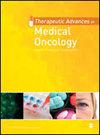Topical heparin as an effective and safe treatment for patients with capecitabine-induced hand-foot syndrome: results of a phase IIA trial supported by proteomic profiling of skin biopsies
IF 4.3
2区 医学
Q2 ONCOLOGY
引用次数: 4
Abstract
Background: Hand-foot syndrome (HFS) is a common adverse reaction associated with capecitabine chemotherapy that significantly affects the quality of life of patients. This study evaluates the safety and effectiveness of a topical heparin (TH) treatment on the clinical manifestations and anatomopathological alterations of capecitabine-induced HFS. In addition, we performed proteome profiling of skin biopsies obtained from patients with HFS at baseline and after heparin treatment. Methods: Patients with grade ⩽ 2 HFS associated with capecitabine were included in this study. The primary end point was the effectiveness of TH in reducing HFS of any grade. Clinical improvement was evaluated by clinicians, and an improvement was perceived by patients who performed a weekly visual analog scale questionnaire. Secondary end points included a comparative histological analysis and protein expression in skin biopsies at baseline and after 3 weeks of HT treatment. Proteomic profiling was carried out using quantitative isobaric labelling and subsequently validated by a T-array. Results: Twenty-one patients were included in the study. The median TH treatment time was 7.6 weeks (range = 3.6–41.6 weeks), and the median response time was 3.01 weeks (95% CI = 2.15–3.97). At the end of treatment, 19 of 21 patients (90.48%) responded to treatment with a decrease in one or more grades of HFS. None of the patients experienced adverse effects related to TH usage, nor did they suspend chemotherapy treatment. The main findings observed in skin biopsies after treatment were a decrease in hyperkeratosis and lymphocytic infiltrates. The proteomic analysis showed altered expression of 34 proteins that were mainly related to wound healing, cell growth, and the immune response. Conclusion: Based on our results, topical heparin is an effective and safe treatment for clinical manifestations of HFS, probably due to the restauration of skin homeostasis after heparin treatment, as supported by our proteomics-derived data. Trial registration: EudraCT 2009-018171-13局部肝素作为卡培他滨诱导的手足综合征患者的一种有效和安全的治疗方法:一项由皮肤活检蛋白质组学分析支持的IIA期试验结果
背景:手足综合征(HFS)是卡培他滨化疗的常见不良反应,严重影响患者的生活质量。本研究评估了局部肝素(TH)治疗卡培他滨诱导的HFS的临床表现和解剖病理改变的安全性和有效性。此外,我们对HFS患者在基线和肝素治疗后的皮肤活检进行了蛋白质组分析。方法:分级患者 ⩽ 本研究包括2例与卡培他滨相关的HFS。主要终点是TH在降低任何级别HFS方面的有效性。临床医生对临床改善进行评估,每周进行视觉模拟量表问卷调查的患者感知到改善。次要终点包括比较组织学分析和HT治疗3周后皮肤活检中的蛋白质表达。使用定量等压标记进行蛋白质组学分析,随后通过T阵列进行验证。结果:21名患者被纳入研究。TH治疗时间中位数为7.6 周(范围 = 3.6–41.6 周),中位反应时间为3.01周(95%置信区间 = 2.15–3.97)。在治疗结束时,21名患者中有19名(90.48%)对治疗有反应,一个或多个级别的HFS降低。没有患者出现与TH使用相关的不良反应,也没有暂停化疗。在治疗后的皮肤活检中观察到的主要结果是角化过度和淋巴细胞浸润减少。蛋白质组学分析显示,34种蛋白质的表达发生了变化,这些蛋白质主要与伤口愈合、细胞生长和免疫反应有关。结论:根据我们的研究结果,局部肝素是治疗HFS临床表现的有效和安全的方法,这可能是由于肝素治疗后皮肤稳态的恢复,我们的蛋白质组学数据支持了这一点。试验注册:EudraCT 2009-018171-13
本文章由计算机程序翻译,如有差异,请以英文原文为准。
求助全文
约1分钟内获得全文
求助全文
来源期刊

Therapeutic Advances in Medical Oncology
ONCOLOGY-
CiteScore
8.20
自引率
2.00%
发文量
160
审稿时长
15 weeks
期刊介绍:
Therapeutic Advances in Medical Oncology is an open access, peer-reviewed journal delivering the highest quality articles, reviews, and scholarly comment on pioneering efforts and innovative studies in the medical treatment of cancer. The journal has a strong clinical and pharmacological focus and is aimed at clinicians and researchers in medical oncology, providing a forum in print and online for publishing the highest quality articles in this area. This journal is a member of the Committee on Publication Ethics (COPE).
 求助内容:
求助内容: 应助结果提醒方式:
应助结果提醒方式:


